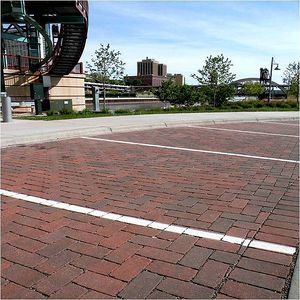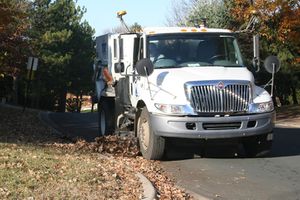
Guidance for meeting dissolved oxygen or oxygen demand TMDL MS4 permit requirements
This page provides information and guidance for MS4 (Municipal Separate Storm Sewer System) permittees who have total maximum daily load (TMDLs) wasteload allocations (WLAs) for dissolved oxygen or oxygen demand.
Contents
Overview
The amount of dissolved oxygen (DO) an aquatic organism needs depends upon species, water temperature, and other factors such as the life stage of an organism. For most Class 2B waters, the DO standard is 5 mg/L as a daily average and 4 mg/L as a daily minimum. Oxygen demand is a measure of the oxygen used by microorganisms to decompose organic matter. Oxygen demand is expressed either as biochemical oxygen demand (BOD), chemical oxygen demand (COD), or nitrogenous oxygen demand (NOD).
- Biochemical oxygen demand is the amount of dissolved oxygen needed by aerobic biological organisms to break down organic material present in a given water sample at certain temperature over a specific time period. The BOD value is most commonly expressed in milligrams of oxygen consumed per litre of sample during 5 days of incubation at 20°C (Wikipedia).
- Chemical oxygen demand (COD) is an indicative measure of the amount of oxygen that can be consumed by reactions in a measured solution. It is commonly expressed in mass of oxygen consumed over volume of solution and expressed in milligrams per litre (mg/L) (Wikipedia).
- Carbonaceous biochemical oxygen demand or CBOD is a method defined test measured by the depletion of dissolved oxygen by biological organisms in a body of water in which the contribution from nitrogenous bacteria has been suppressed (Wikipedia).
- Nitrogenous oxygen demand (NOD) is a quantitative measure of the amount of dissolved oxygen required for the biological oxidation of nitrogenous material, for example, nitrogen in ammonia, and organic nitrogen in waste water (Organisation for Economic Co-operation and Development).
- Total oxygen demand (TOD) defines the total oxygen demand of the water sample.
Waters that have adequate DO under natural conditions but that are impaired for DO typically have one or more anthropogenic sources of organic matter that create an oxygen demand. For urban stormwater, examples of organic matter sources include leaves and other yard wastes, pet and animal wastes, fertilizer, sediment containing organic matter (e.g. topsoil), and hydrocarbons (e.g. oil). A median value for BOD in stormwater runoff in urban settings is about 8 mg/L, while a median value for COD is about 22 mg/L. These BOD levels are greater than Class 2B water quality standards, which range from 1.5 to 3.5 depending on geographic location.
Total Maximum Daily Loads (TMDLs) with BOD or COD wasteload allocations for MS4s
Currently there are three approved total maximum daily load (TMDLs) - for Hardwood Creek (Waterbody ID: 07010206-596), Trott Brook (Waterbody ID: 07010207-680), and Buffalo Creek (Waterbody ID: 07010205-638 (formerly 07010205-501)) - that include MS4 (Municipal Separate Storm Sewer System) wasteload allocations (WLAs) for oxygen demand that are not assigned a zero percent reduction. Hardwood Creek is impaired for aquatic life (fish) due to low dissolved oxygen and Trott Brook and Buffalo Creek are impaired for aquatic life (fish and aquatic macroinvertebrates) due to low dissolved oxygen.
MS4s with applicable dissolved oxygen/oxygen demand WLAs
Link to this table
| TMDL Project | MS4 with a WLA for oxygen demand |
|---|---|
| Hardwood Creek Impaired Biota and Dissolved Oxygen TMDL | Anoka County |
| Hugo City | |
| Lino Lakes City | |
| MNDOT Metro District | |
| Rice Creek Watershed District | |
| Washington County | |
| Trott Brook (Rum River Watershed TMDL) | Elk River City |
| Nowthen City | |
| Ramsey City | |
| Saint Francis City | |
| Sherburne County | |
| Buffalo Creek (South Fork Crow River Watershed TMDL) | Glencoe City |
MS4 permit requirements
A compliance schedule is a a schedule of compliance leading to compliance with Clean Water Act regulations. Compliance schedules must meet the following.
|
Sections 12.8 and 22.2 of the MS4 permit provides the requirements for permittees who have a TMDL WLA for dissolved oxygen or oxygen demand.
Section 12.8: The applicant must submit a compliance schedule for each applicable Waste Load Allocation (WLA) not being met for oxygen demand, nitrate, total suspended solids (TSS), and total phosphorus (TP). The applicant may develop a compliance schedule to include multiple WLAs. The applicant's compliance schedule must include the following information:
a. proposed BMPs or progress toward implementation of BMPs to be achieved during the permit term;
b. the year each BMP is expected to be implemented;
c. a target year the applicable WLA(s) will be achieved
Section 22.2: If the permittee has an applicable WLA not being met for dissolved oxygen or oxygen demand, nitrate, TSS, or TP, the permittee must provide a summary of the permittee's progress toward achieving those applicable WLAs with the annual report. The summary must include the following information:
a. a list of all BMPs applied towards achieving applicable WLAs for oxygen demand, nitrate, TSS, and TP;
b. the implementation status of BMPs included in the compliance schedule at the time of final application submittal;.

Meeting permit requirements for oxygen demand
The following discussion provides guidance for the condition where a permittee claims to meet an oxygen demand WLA and the condition where the WLA is not met at the time of application.
Guidance for permittee claiming to meet an oxygen demand WLA
The MS4 permit does not specifically describe requirements for permittees claiming to meet a WLA for oxygen demand. Because there may be multiple sources of oxygen demand, it is not possible to directly calculate reductions in oxygen demand associated with implementation of specific BMPs. Consequently, permittees can claim to meet an oxygen demand using one of two methods.
- Monitor stormwater runoff to determine oxygen demand. General guidance for monitoring stormwater runoff can be found at this link. Guidance for collecting samples for oxygen demand can be found at the following links.
- If the TMDL report specifically provides translation of creditable pollutants into oxygen demand, permittees can calculate loads or reductions in loads for oxygen demand. For example, if reduction of one pound of phosphorus can be translated into a specific quantity of oxygen demand, implementation of BMPs that reduce phosphorus can be used to quantify loads for oxygen demand.
MPCA does not currently provide pollutant reduction credits for organic carbon (organic matter) and specific BMPs. These credits could potentially be developed upon request.
Guidance for permittees not meeting an oxygen demand WLA
The MS4 permit does not require permittees to quantify pollutant loading for oxygen demand. Consequently, MPCA recommends including BMPs/activities in your MS4’s compliance schedule that reduce organic matter and carbon (e.g. leaf litter), since these BMPs/activities will also reduce oxygen-demanding substances in the streams (see table below). Most BMPs that reduce organic matter (e.g. street sweeping), will also reduce phosphorus, sediment and/or bacteria (Escherichia (E.) coli, fecal coliform) loading to waterbodies. Additionally, if BMPs/activities are implemented across the entire jurisdictional area of your MS4, some activities may be used to demonstrate progress towards additional applicable phosphorus, total suspended solids (TSS), and/or bacteria (E. coli, fecal coliform) WLAs.
Other sources of oxygen demand in urban stormwater runoff include animal and food waste, trash, gasoline and motor oil, heavy metals, fertilizers, and pesticides. The following table lists some stormwater practices that may be effective in reducing oxygen demand in stormwater runoff. The list is not comprehensive and any practice that removes phosphorus or TSS will also likely reduce oxygen demand. If BMPs are targeted toward oxygen demand, practices that reduce organic matter will be most effective.
Permittees have two permit requirements for oxygen demand WLAs not being met.
- Section 12.8 requires the permittee to submit a compliance schedule with their SWPPP at the time of application. Permittees should reference Guidance for completing the MS4 Permit TMDL Application Form.
- Section 22.2 requires the permittee to submit an annual report demonstrating progress toward meeting their WLA(s). Guidance for completing the annual report is found here. NOTE: the guidance for the annual report reflects the 2013 permit and will be updated in early 2021 to reflect the 2020 permit.
Potential sources of organic matter and carbon and BMPs/Activities that could be included in your compliance schedule to address dissolved oxygen/oxygen demand applicable WLAs
Link to this table
| General Category | Source | BMP/Activity |
|---|---|---|
| MS4 Infrastructure | Decaying plant matter, litter, and sediment in the storm drain system | Enhance street sweeping program |
| Remove leaf litter and soil in street and gutters (e.g. implement an Adopt-a-storm drain program). Educate property owners on proper yard waste management | ||
| Stormwater runoff from impervious surfaces | Implement source, rate, volume controls (i.e. adopt minimal impact design standards (MIDS) for new, redevelopment, and linear projects) | |
| Minimize impervious surfaces | ||
| Implement filtration practices, infiltration practices, and sedimentation practices | ||
| Domestic pets | Dogs, cats, dog parks, walking trails, residential yard and sidewalk runoff (spring runoff after winter accumulation) | Install pet waste disposal stations along trails, in dog parks, etc |
| Pass and enforce pet waste ordinances and educate pet owners about them | ||
| Add infiltration BMPs downstream of parks/residential areas and upstream of stormwater pipes (i.e., somewhere between the park/residential area and the stormwater outfall to intercept and infiltrate some or all of the flow from these areas) | ||
| Residential sources | See this section | |
| Industrial and commercial practices | See this section | |
Additional information
Additional information on potential BMPs/activities to address the Hardwood Creek, Trott Brook Creek, and Buffalo Creek dissolved oxygen impairments may also be available in the following:
Hardwood Creek TMDL
- TMDL Report
- TMDL Implementation Plan
- Rice Creek Watershed District Comprehensive Watershed Management Plan
Rum River Watershed TMDL
South Fork Crow River Watershed TMDL
References
The following references provide information on oxygen demand.
- Reduction in Mean Chemical Oxygen Demand [COD Due to Tree Cover]
- An Investigation of the Relationships between Rainfall Conditions and Pollutant Wash-Off from the Paved Road
- Effect of TSS Removal from Stormwater by Mixed Media Column on T-N, T-P, and Organic Material Removal
- Pollutants
- Chemical Oxygen Demand
Related Pages
Additional information and guidance related to TMDLs may be found at this link.
This page was last edited on 22 January 2023, at 14:21.

